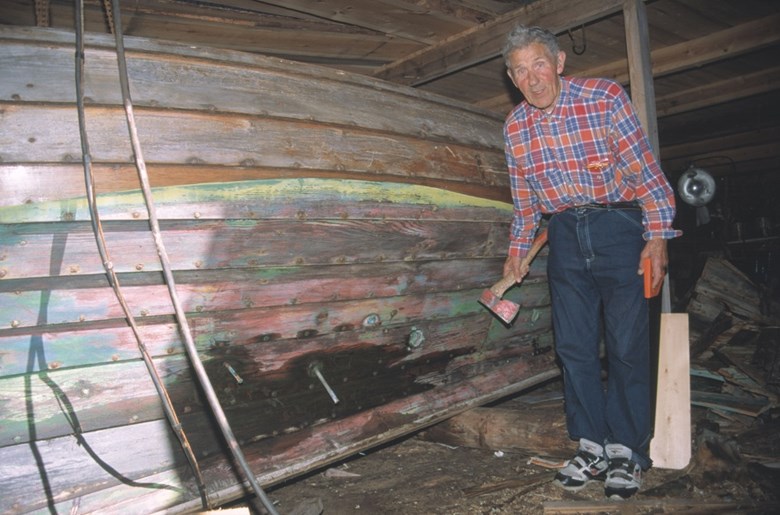A great many vessels in Solund
Around 1950, there were more than 400 registered fishing vessels and motor boats in Solund. No surprise in this since the whole population lived on islands, and until that year, without roads. The motor boat was as vital for business as for other transport purposes. The owner as a rule maintained the boat himself. But when a new engine was to be installed, boat boards and keel planks replaced, the safest way was to have it done by somebody who had the know-how, the materials, and the tools.
On the islands there were quite a few handy people who took on such work. They were all self-educated, who started on a small scale on their own beach. The jobs grew with experience.
Axe chips on boathouse floors
Even big vessels stood on primitive soaped slips on the sandy beach, heavy engines being installed. When electric power was available in the early 1950s, the repair work became much easier.
Some took on work only when there was a break from fishing or other seasonal activities. Others made a full-time living of it. One of the best known was Martinus Lågøy. He set up shop at Lågøyvågen, at the quays and sea warehouses which belonged to the family farm. On the same bay, a short distance away, Kristoffer Mathiesen had built the Lågøy yard and mechanical workshop. They were both flexible and cooperated well.

The housewives gave a hand
In the coast community, it was extremely important to have people nearby who had the insight and got work done without too high costs. Martinus Lågøy picked up first-class materials at Amla and Frønningen in eastern Sogn. He had to have a large stock of gears and pitch, bolts, and nails.
The boat building traditions and knowledge of vessels were mere child's play to Martinus. Moreover, at both companies at Lågøy the customers were met by good-natured service. In addition, there was a hospitality which many made use of. Room and board in the Lågøy houses was quite common for many who needed a job done in a day, or two, or three.
Long, full days
One day the boat repairman would make watertight bulkheads and install well valves in a trolling vessel, quality valves made at the workshop. The next job would be to give the side of a vessel new boards, change railing supports and deck planks. On a moment's notice he would leave the job and present himself at the slip: a fishing vessel had a loose casing and was taking in water. Somebody else had to change the few soft planks.
At the crack of dawn the sounds started at Lågøyvågen, because most jobs were urgent. A lot of thinking was needed to develop efficient work methods, especially when one man single-handedly was expected to upgrade a whole vessel.
From motor fishing vessel to miniatures
The boat repairman on occasions found time to be a pure builder. Boat the size of a fishing boat was launched, later a holiday boat or two, of up to 35 feet. The plastic material was also introduced in the Lågøy sea warehouses.
The hardworking craftsman became an institution. So it was difficult for him to lay down the tools when the years and lack of strength made it harder to handle the hammer and the axe. The size must be reduced. Now, in the year 2001, the boat builder Martinius Lågøy conjures forth the finest miniatures, exactly reduced in size in accordance with the original designs of known vessels from Solund. They will survive the man and the work, and they are precious memorials of activities which were so vital for the coast community to function.





